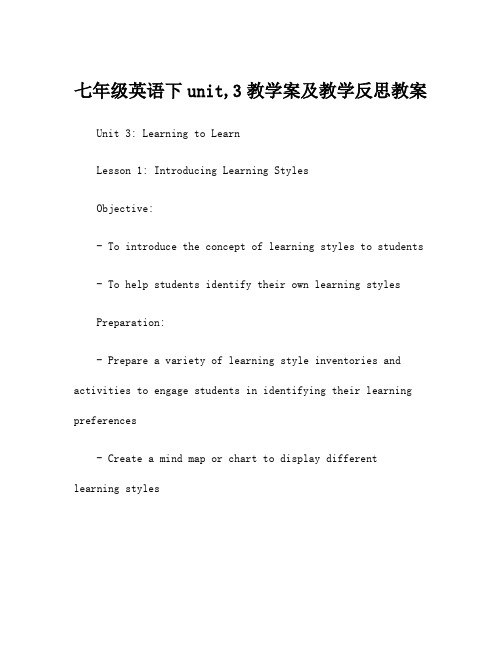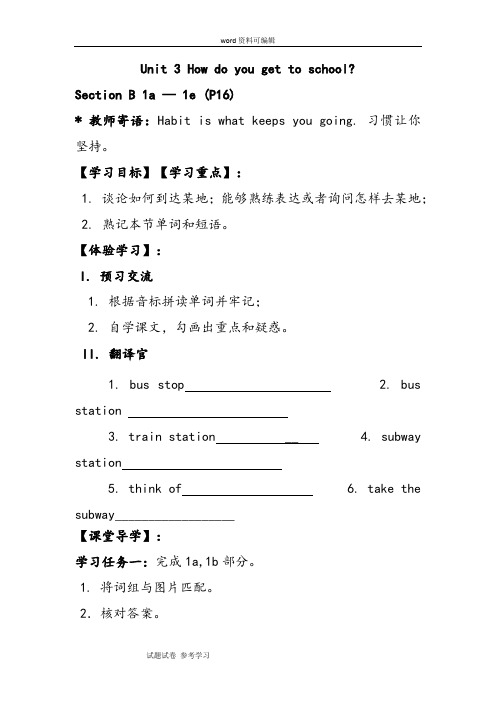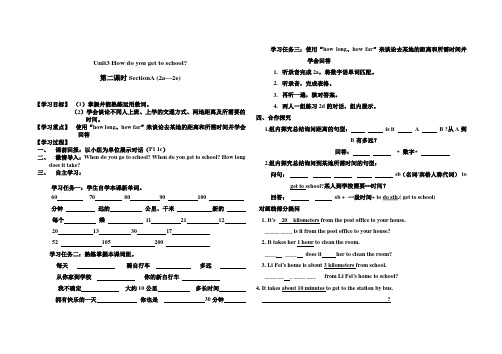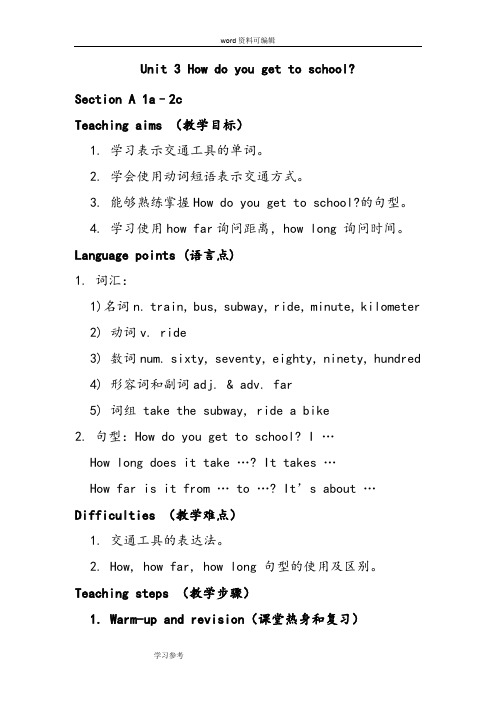改版后(2012)七年级英语 下Unit 3学案
英语人教新目标七年级下册2012年新编Unit3SectionA教案4

Unit 3 How do you get to school? Section A (1a-2e)一、教学目标:1. 语言知识目标:1) 能掌握以下单词:train, bus, subway, ride, bike, sixty, seventy, eighty, ninety, hundred, far, minute, kilometer, new, every, every day 2) 能掌握以下句型:①—How do you get to school? —I ride my bike.②—How does Mary get to school? —She takes the subway.2. Talk about how to get to places (谈论出行方式)take the bus /subway /train /taxi , ride a bike /walk .3. how引导的特殊疑问句,表示乘坐何种交通工具的方式。
how far, how long 引导的特殊疑问句。
4. 复习基数词及时间的表示方法。
2. 情感态度价值观目标:让学生感受到他们学习英语是为了在现实生活中进行交流,而不单纯是为了英语课和应付考试而学习,了解东西方国家出行方式的不同,以及不同的交通规则,教育学生注意交通安全, 加深对交通知识的了解。
倡导自觉遵守交通法规及礼貌,构建和谐的人际关系。
了解交通的发展,培养创新精神。
二、教学重难点1. 教学重点:1) how /how far /how long 引导的特殊疑问句. 2) 乘坐交通工具的表示方法.3) It takes / sb some time to do sth . 2. 教学难点:—How do you get to school? —I take the …/ride …/ walk…—How does Mary get to school? —She takes the subway.—How long does it take? —It takes forty minutes.—How far is it from… to…—It's… kilometers. 三、教学过程Ⅰ. Warming-up and Lead in 学生和老师进行简单的问候Ss : Good morning , teacher.T: Good morning, classT: Look at the picture. What can you see? Do you like your school? I usually get to school by bike, but sometimes on foot. How do you get to school? Ss 按实际情况作答S1: I ride my bike. S2: I go by bus. S3: …T: Very good. You're clever. Let's learn Unit 4 Section A. 之后板书:“Unit 4 How do you get to school?”Ⅱ. Presentation1. T: If you are here, but your school is in Shanghai. How do you get to school? Ss: I take the bus /plane/ boat / ship / car / taxi I ride a bike / motorbike T: Do you know any other way?2. Teacher shows pictures on the big screen. 归纳出行方式和常用短语。
七年级英语下册unit3教案课堂教学设计

本文将分享一份关于七年级英语下册Unit 3的课堂教学设计。
这一单元的主题是“Excuse me, where’s the post office?”,旨在帮助学生学会寻问和指示方向。
一、教学目标1.学生能够利用“Excuse me, where’s…?”和“Go straight / Turn left /Turn right / Do a U-turn…”等相关表达方式寻问和指示方向。
2.学生能够掌握交通工具和要素的相关单词和短语,如bus stop, subway, trainstation, etc.3.学生能够在交流中理解和使用地图和城市布局相关的词汇。
二、教学准备1.PowerPoint演示文稿2.学习用的绘画和游戏材料3.相关练习题和课堂活动材料三、教学步骤1.导入引入问题:幻灯片上展示一张城市地图,要求学生根据已知的地标(如学校、体育场、购物中心等)找出周围的其他地方。
2.学习交通工具和要素教师通过幻灯片展示不同的交通工具和点。
继续讨论如何利用不同的交通工具到达一个点,例如,利用地铁从学校到达电影院:Excuse me, how do I get to the movie theater?Take the subway.Where's the subway?Turn right and go straight. The station is on your left.3.教学寻问和指示方向教师在幻灯片上展示不同地理位置的照片和地图,提示学生开始学习如何问路和指路。
教师向学生展示如何使用“Excuse me, where’s…?”句型,以及“Go straight / Turn left / Turn right / Do a U-turn…”等表达方式来指示方向。
教师可以与学生分组进行角色扮演,以加强他们的语言进程和提高他们的口语表达能力。
4.练习方向、地图和城市布局相关的词汇通过游戏、图片和绘画等多种形式收集和展示不同的地图和城市布局相关的单词和短语,例如:Bus stop / Subway / Train stationNorth / South / East / WestOn the left / On the right / Across the street / Next to5.面向现实场景的实践通过现实场景的练习加强学生的学习效果。
七年级下册英语unit3教案

七年级下册英语unit3教案教案标题:七年级下册英语Unit 3教案教学目标:1. 通过本单元的学习,学生将能够掌握有关描述人物外貌特征的词汇,并能够用英语进行简单的人物描述。
2. 学生将能够运用所学的词汇和句型,进行有关人物特征的问答和对话。
3. 学生将培养观察力和描述能力,提高他们的口语表达能力。
教学重点:1. 掌握描述人物外貌特征的词汇。
2. 学会用英语进行简单的人物描述。
3. 运用所学的词汇和句型进行问答和对话。
教学难点:1. 运用所学的词汇和句型进行实际对话练习。
2. 提高学生的观察力和描述能力。
教学准备:1. 多媒体设备及相关教学资源。
2. 单词卡片、图片或者海报等辅助教具。
3. 练习题和活动手册。
教学过程:Step 1: 导入新课 (5分钟)1. 利用图片或者海报展示不同的人物外貌特征,引起学生的兴趣。
2. 引导学生观察图片,让他们描述图片中的人物外貌特征。
Step 2: 词汇学习 (15分钟)1. 呈现并教授与人物外貌特征相关的词汇,如hair, eyes, nose, mouth, tall, short 等。
2. 运用图片或者实物,帮助学生理解和记忆这些词汇。
3. 进行词汇练习,巩固学生对这些词汇的掌握。
Step 3: 句型学习 (15分钟)1. 呈现并教授描述人物外貌特征的句型,如"He/She has + adj. + noun."。
2. 通过示范和操练,让学生掌握并运用这个句型进行人物描述。
3. 进行句型练习,巩固学生对这个句型的掌握。
Step 4: 对话练习 (20分钟)1. 分组进行对话练习,让学生运用所学的词汇和句型进行问答和对话。
2. 教师巡回指导,纠正学生的发音和语法错误。
3. 鼓励学生展示他们的对话成果,提高他们的口语表达能力。
Step 5: 拓展活动 (10分钟)1. 让学生以小组为单位,选择一位他们喜欢的名人进行人物描述,并展示给全班。
初中英语_初中英语七年级下册 Unit3教学设计学情分析教材分析课后反思

Unit 3 How do you get to school?第二课时Section A(2d-3c)【教师寄语】Seeing is believing.【Free talk】Talk about how you get to school【Learning tasks】掌握以下单词和句型:1、询问怎样到达某处;2、表示需要多少时间到达某处。
【Importance and difficulties】学会出行方式及时间的问和答。
【学习过程】一、超前预习I. 请试着写出下列短语。
get to____ ____ how long______ __ how far______ __from to______ __ get up___ _____ leave for_____ ___has a quick breakfast___ ______the bus station___ __ride one'bicycle to_____ ___ take sb.to___ ____ take the subway____ ___ look at_____ __II. 你能通过预习说出下的句子吗?1、他是如何到校的?他每天步行到校。
2、他每天步行到校要花多少时间?要花大约20分钟。
3、从他家到学校大约有多远?大约有3公里。
Ⅲ. 找出你的疑惑:__________________________________________二、课中学习I. 预习检测II. 解决疑惑自主互助学习知识剖析:take的具体用法take的本义是“carry sh/sth from one place to another”,即“携带,运载”。
但灵活的它在不同的场合有不同的含义。
(1)表示“乘、坐”某一交通工具。
例如:My father usually takes a bus to work.我爸爸常乘公共汽车去上班。
注意:take和by都有“乘、坐”之意。
七年级英语下册unit3教案

七年级英语下册unit3教案教案标题:七年级英语下册 Unit 3 教案教学目标:1. 通过本单元的学习,学生将能够掌握有关描述人物外貌特征和性格特点的词汇。
2. 学生将能够使用所学的词汇和句型进行简单的人物描述和对话。
3. 学生将能够通过听、说、读、写的综合训练提高他们的英语综合运用能力。
教学重点:1. 掌握人物外貌特征和性格特点的词汇。
2. 学会使用所学的词汇和句型进行简单的人物描述和对话。
教学难点:1. 学生能够灵活运用所学的词汇和句型进行口头表达。
2. 学生能够进行听力和阅读理解,并能够写出简单的人物描述。
教学准备:1. 教材:七年级英语下册教材 Unit 3 部分。
2. 多媒体设备:投影仪、电脑等。
3. 教学资源:图片、录音等。
教学过程:Step 1: 导入新课 (5分钟)1. Greet the students and ask them about their favorite celebrities or famous people.2. Show pictures of different celebrities and ask students to describe theirappearance and personality traits.Step 2: 学习新词汇 (15分钟)1. Introduce new vocabulary related to physical appearance and personality traits.2. Use flashcards, pictures, and gestures to help students understand and remember the new words.3. Practice pronunciation and spelling of the new words.Step 3: 听力训练 (15分钟)1. Play a recording of a conversation between two people describing their friends.2. Students listen and try to identify the physical appearance and personality traits mentioned in the conversation.3. Check the answers as a class and discuss any difficulties or questions.Step 4: 口语练习 (20分钟)1. Divide the class into pairs or small groups.2. Students take turns describing their favorite celebrities or famous people using the new vocabulary and sentence patterns.3. Encourage students to ask questions and have conversations about each other's descriptions.Step 5: 阅读理解 (15分钟)1. Provide students with a short reading passage about a famous person.2. Students read the passage individually and answer comprehension questions.3. Check the answers as a class and discuss any challenging vocabulary or concepts.Step 6: 书面表达 (15分钟)1. Ask students to choose a famous person they admire and write a short paragraph describing their appearance and personality traits.2. Encourage students to use the new vocabulary and sentence patterns learned in class.3. Collect and review the written paragraphs for assessment and feedback. Step 7: 总结和复习 (5分钟)1. Review the key vocabulary and sentence patterns covered in the lesson.2. Summarize the main points and encourage students to ask any remaining questions.教学延伸:1. 为学生提供更多的听力材料,让他们熟悉不同口音和语速。
七年级下册unit3教案

七年级下册unit3教案教案标题:七年级下册 Unit 3 教案教案目标:1. 通过本单元的学习,学生将能够掌握有关描述人物外貌特征和个性特点的词汇和句型。
2. 学会使用形容词来描述人物的外貌特征和个性特点。
3. 提高学生听、说、读、写的能力,培养他们的语言表达能力和交际能力。
教学重点:1. 学习并掌握有关人物外貌特征和个性特点的词汇和句型。
2. 运用所学知识进行听、说、读、写的综合训练。
教学难点:1. 学生能够正确运用所学的形容词来描述人物。
2. 学生能够用英语进行简单的人物描述和交流。
教学准备:1. 教材:七年级下册英语教材 Unit 32. 多媒体设备:投影仪、电脑等3. 教学辅助材料:词汇表、图片、录音机等教学过程:Step 1: Warm-up (热身活动)1. 让学生观看一些图片,描述图片中的人物外貌特征和个性特点。
2. 引导学生用英语进行简单的人物描述和交流。
Step 2: Presentation (呈现)1. 呈现并教授本单元的词汇和句型,如:tall, short, long hair, short hair, friendly, outgoing, etc.2. 通过图片、示范和多媒体等方式帮助学生理解和记忆所学内容。
Step 3: Practice (练习)1. 进行听力练习,播放录音,让学生根据听到的描述选择正确的图片。
2. 进行口语练习,让学生两人一组互相描述自己和对方的外貌特征和个性特点。
Step 4: Consolidation (巩固)1. 组织学生进行小组活动,让他们根据所学内容创作一个简短的对话,描述自己和他人的外貌和个性。
2. 鼓励学生积极参与讨论和交流,提高他们的口语表达能力。
Step 5: Extension (拓展)1. 让学生用所学词汇和句型写一篇关于自己或他人的短文,描述外貌和个性特点。
2. 学生可以互相交换作文并互相评价,提出改进建议。
Step 6: Summary (总结)1. 回顾本节课所学的内容,让学生总结所学的词汇和句型。
新目标2012版七年英语下册三单元导学案

六合中心学校六年级英语导学案班级姓名课题Unit 3 How do yougo to school?课型预习+展示课时 4 主备刘凤媛副备段丽娜审稿备课时间2013.4 授课时间领导审核教学目标知识与技能 1.谈论如何到达某地;学会用how 来问路2.学习how对交通方式提问的特殊疑问句过程与方法小组合作探究情感态度与价值观培养学生用英语表达如何到达某地。
教学重点一般现在时态的用法教学难点巩固how对交通方式的提问和how long对时间段的提问以及how far 对距离和路程的提问教学内容引导点拨教学流程Section A 一.预习检测翻译官1.到校_______________2.坐火车___________________3.坐公汽______________4.乘地铁___________________ 4.骑单车______________教学流程5.骑单车______________6. 步行_____________________5.到达________________6. 多远_______________7.乘坐地铁__________8.乘公交车___________________9.乘火车____________________10.八十八___________________11.你样去学校_________________________12.这花费你多长时间?________________________英汉对对碰:Match each word with the right Chinese meaning.二.师生合作探究1、It takes about 15 minutes to walkIt takes sb some time to do sth的意思是花费某人多少时间做某事注意to do如:It took me an hour ______(write ) the letter .如果我们提问时间宾语时,就用_________引导的句型。
七年级英语下unit,3教学案及教学反思教案

七年级英语下unit,3教学案及教学反思教案Unit 3: Learning to LearnLesson 1: Introducing Learning StylesObjective:- To introduce the concept of learning styles to students - To help students identify their own learning stylesPreparation:- Prepare a variety of learning style inventories and activities to engage students in identifying their learning preferences- Create a mind map or chart to display different learning styles- Prepare examples of famous individuals who achieved success by understanding and utilizing their learning style effectivelyProcedure:1. Opening (5 minutes)- Greet the students and introduce the topic of learning styles.- Explain the importance of understanding one's learning style in order to maximize learning potential.2. Presentation (15 minutes)- Present a brief overview of the different types of learning styles such as visual, auditory, and kinesthetic.- Use the mind map or chart to highlight the characteristics of each learning style.3. Activities (20 minutes)- Engage students in various activities to help them identify their own learning style, such as self-assessment quizzes, group discussions, and interactive exercises.- Encourage students to reflect on past learning experiences to determine which style they are most comfortable with.4. Discussion (10 minutes)- Facilitate a class discussion on the advantages and disadvantages of each learning style.- Discuss the idea that individuals can have a combination of learning styles and that understanding this can help them adapt to different learning situations.5. Conclusion (5 minutes)- Summarize the main points of the lesson and emphasize the importance of recognizing and utilizing one's learning style.Lesson 1 Reflection:The introduction of learning styles was well received by the students. They actively participated in the activities and demonstrated a strong interest in understanding their own learning preferences. The use of examples of successful individuals who embraced their learning styles effectively helped to inspire the students and highlight the practical application of the concept. Overall, the lesson achieved its objective of introducing the concept of learning styles and helping students identify their own preferences.Lesson 2: Study Habits and Time ManagementObjective:- To introduce effective study habits and time management techniques to students- To encourage students to develop a personalized study planPreparation:- Prepare a list of effective study habits and time management techniques- Create a study plan template for students to fill out - Gather examples of study schedules and time management toolsProcedure:1. Opening (5 minutes)- Review the concept of learning styles and emphasize the importance of applying effective study habits and time management techniques to maximize learning potential.2. Presentation (15 minutes)- Present a list of effective study habits and time management techniques, such as setting goals, creating a study environment, prioritizing tasks, and using time management tools.- Discuss the benefits of each technique and provide examples of how they can be applied in real-life situations.3. Activities (20 minutes)- Engage students in a hands-on activity to create their own study plan based on their learning style and personal goals.- Encourage students to share and discuss their study plans with their peers for feedback and improvement.4. Group Discussion (10 minutes)- Facilitate a group discussion on common challenges and solutions related to time management and effective study habits.- Encourage students to share their own experiences and strategies for overcoming study obstacles.5. Conclusion (5 minutes)- Summarize the main points of the lesson and emphasize the importance of developing personalized study habits and time management techniques.Lesson 2 Reflection:The presentation of effective study habits and time management techniques was well received by the students. They actively participated in creating their study plans and demonstrated a strong understanding of how to apply the techniques to their own learning situations. The group discussion allowed students to share their own experiences and learn from each other, creating a supportive and collaborative learning environment. Overall, the lesson successfully introduced students to effective study habits and time management techniques and encouraged them to develop personalized study plans.In conclusion, the unit on learning to learn was an engaging and informative experience for the students. Thelessons effectively introduced the concepts of learning styles, study habits, and time management techniques, and encouraged students to reflect on their own learning preferences and develop personalized strategies for success. The active participation and enthusiasm of the students demonstrated their genuine interest in understanding how to learn effectively, setting a strong foundation for their future academic endeavors.。
七年级下册英语教案(第三单元)

二 、教学重、难点:
Learning to talk about how to get to places.
Useful expressions
三、教学方法:“五步、双重教学法〞
四、教具准备:课文录音
五、教学过程:
〔一〕复习旧知
Review the sentences and the phrases that we learned yesterday!
3.教师在黑板上画出一个简要的示意图。边画边将自己上班的路线讲述给学生。
4.引导学生能够讲出自己的路线
〔三〕自学新知
1. Let students listen to1c-1e.
2. Let them read the passage about 2B
3. Answer the questions and write the answers !
【教师精心设计典例分析】
备注:
课题【Unit 3 How do you get to school?】
科目【英语】年级【七年级】
课时【Period3】授课教师
一、教学目标:
1、知识目标:●To learn to talk abouthow to get to places.
●To learn to usehow, how long, how far
2、能力目标:Talk about Transportation..
3、情感目标:学生能够礼貌的使用英文互相询问!
二 、教学重、难点:
Learning to talk about how to get to places.
Useful expressions
七年级英语下册unit3教学设计

七年级英语Unit 3 How do you get to school? sectionA(1a-1c)对交通工具以及特点有了更进一步的认识,并且扩充了词汇量,学生通过和老师交流,慢慢放松,参与到教学中来。
)Step2 Presentation1.Teacher: How do you go to school? Student1: I take the bus to school.Teacher: How do you go to school? Student2: …….Teacher: How do you go to school? Student3:(设计说明:《新课程标准》强调重视利用直观教具和现代化教学手段,努力创设英语环境,遵循方便,简洁,真实,直观的原则。
这一环节主要是语块的学习,通过句型框架的展现来学习正确的语块知识。
本环节中,利用PPT课件,直观清晰的展示所教授的语块知识,课件中音标的展现,可以更充分理解新语言项目的音,形,意)Teacher: How does your farther go to Shanghai? Students: He takes the train to Shanghai/ He goes to Shanghai by train.(设计说明:英语教学的迁移非常重要,由第一人称向第三人称迁移,知识的教授不单纯的局限于书本上,还需要拓展,以扩大学生的知识面,扩充了同义句,使学生丰富所学知识,迁移运用,活学活用,不但可以应付考试,还可以将所学知识真正用到交际中。
)Look!Who is that woman ? she is Mrs Huang .T :how do I go to work?Student1:Maybe you take the train.T: No ,my home is near school,I don’t have to take it.S2: Maybe you ride the bike.T: No,it is boring ,I do not like it.S3: Maybe you take the subway.T: No, there is no subway station near here .S4: Maybe you take the taxi.T: No, it is too expensive,I don’t have much money.S5: Maybe you go to work on foot.T: Really?How do you know that?S5: I guess.()T; on foot means walk. I walk to work.I go to work on foot.But sometimes I run to work.Because I am afraid I am late.So I am never late for class.(设计说明:用熟悉的人和熟悉的场景,来引导学生记忆刚学过的知识,巩固旧知识,“温故而知新”用on foot引出新词组:walk to; run to ,抓住用英语交际的机会,在交际中把注意力集中在意思的表达上,必要时借助手势和表情。
英语人教新目标七年级下册(2012年新编)Unit 3 Section B 教案1

Unit 3 How do you get to school?Section B 1a — 1e (P16)* 教师寄语:Habit is what keeps you going. 习惯让你坚持。
【学习目标】【学习重点】:1. 谈论如何到达某地;能够熟练表达或者询问怎样去某地;2. 熟记本节单词和短语。
【体验学习】:I. 预习交流1. 根据音标拼读单词并牢记;2. 自学课文,勾画出重点和疑惑。
II. 翻译官1. bus stop2. bus station3. train station __4. subway station5. think of6. take the subway__________________【课堂导学】:学习任务一:完成1a,1b部分。
1. 将词组与图片匹配。
2.核对答案。
3.知识呈现,讲述自己的上学方式(两种)。
4. 分组练习1b的对话学习任务二:完成1c,1d部分。
1. 听录音,并完成1c.2. 听录音,核对1c的答案。
3. 再听一遍,完成1d并在组内核对答案。
4. 学生质疑,师生共同解惑。
学习任务三:完成1e部分。
1. 口头谈论Bob去爷爷家的方式。
2. 将Bob去爷爷家的方式写成英语句子并展示。
Section B 2a — 2c (P17)* 教师寄语:Habit is what keeps you going. 习惯让你坚持。
【学习目标】【学习重点】:1.掌握本节单词和短语。
2. 理解本课文章,培养学生用英语表达如何到达某地。
【体验学习】:I. 预习交流1. 找出本节课的新单词和短语并牢记。
2. 自学课文,勾画出重点和难点。
II. 翻译官1. 许多____________________2. 村庄___________________3. 两者之间________________4. 桥_____________________5. 小船____________________6. 索道___________________7. 梦想____________________ 8. 害怕__________________9. 村民____________________ 10. 实现__________________【课堂导学】:学习任务一:谈论上学方式。
【七年级】七年级英语下册Unit 3 Finding your way学案

【七年级】七年级英语下册Unit 3 Finding your way学案【七年级】七年级英语下册unit3findingyourway学案第三单元找到你的路学习目标:1.介绍有关位置和交通的话题。
2.谈论参观访问和交通方式。
3.辨别方位。
新课预习将下列词语翻译成中文知道路吗?爬上山____________跟随我__________________在北京的西南_______________下车,坐地铁到市中心去____________________不要害怕________________不得不________________春游,远足________________课堂训练一、根据地理位置用适当的位置词填空。
1.guangzhouisinthe____________ofchina.2.北京是中国的城市。
3.shanghaiisinthe______________ofchina4.昆明是中国的城市。
5.harbinisinthe________________ofchina.6.新疆是中国的新疆。
二、根据汉语提示及所给词的适当形式完成下列句子。
1.我们害怕老虎2.mydaughterlikes___________(跟随)metogoshopping.3.我确信我知道这条路4.it’srainingoutside.he____________(haveto)stayathome.5.我们明天去学校吧。
6.ittakeshalfanhour___________(drive)tothelakepark.三、根据第43页给出的图表和首字母完成对话。
a:e________m__________.whereisthesunnysidegarden?b:它是动物园的。
a:h________canigetthere?b:你可以乘其他的公共汽车。
a:w_________busshallit____________?b:没有。
英语人教新目标七年级下册(2012年新编)Unit 3 Section B 教案3

Unit 3 How do you get to school?Section B (1a—1e&3a—3b)Teaching Aims and Demands:Key phrases: bus stop, bus station, train station, subway station, think of Important drills:①Mary wants to know how far he lives from his grandparents’ home.②Mary wants to know what he thinks of the trip.Teaching Procedures:Step1 Preview根据实际情况回答问题(至少用两种方式)。
How do you get to school?_________________________ _________________________预习Section B(1a—1e&3a—3b)1.公共汽车站________________2.地铁站________________3.他祖父母的家________________4.到达________________5.认为________________6.和我的同学交谈________________Step 2 Exploration1. New words:① Let’s look at pictures about some places on the blackboard. Please think about how to say them in English.② Display the new words below.Bus stop bus station train station subway station③ Match the words with the pictures. (1a)2. Pair work (1b)How do you get to school? Tell your partner two types of transportation. Here is an example:A: How do you get to school?B: Well, I ride my bike to the subway station. Then I take the subway.3. Listening practice①Listen and check the things that Mary wants to know. (1c)②Listen again and check how Bob gets to his grandparents’ home. (1d)③Listen and imitate.4. Pair work (1e)Talk about how Bob gets to his grandparents’ home according to the right route picture in 1d.A: How does Bob get to his grandparents’ home?B: He…5. Reading (3a)① Read the e-mail fast and answer what it is mainly about.___________________________________________② Fill in the blanks with the words in the box.③ Read again carefully and answer the questions.(1)How does Tom get to school?______________________________________________________________________________________(2)Is the bus ride boring? Why?___________________________________________④ Retell the passage.6. Writing (3b)Write an e-mail to Tom and tell him how you get to school.Step 3 ExplanationMary wants to know what he thinks of the trip. 玛丽想知道他认为旅程怎么样。
七年级下册英语unit 3导学案

Unit3 How do you get to school?第二课时SectionA (2a—2e)【学习目标】(1)掌握并能熟练运用数词。
(2)学会谈论不同人上班、上学的交通方式、两地距离及所需要的时间。
【学习重点】使用“how long、how far”来谈论去某地的距离和所需时间并学会回答【学习过程】一、课前回报:以小组为单位展示对话(P1 1c)二、激情导入:When do you go to school? When do you get to school? How longdoes it take?三、自主学习:学习任务一:学生自学本课新单词。
60 70 80 90 100分钟远的公里、千米新的每个乘11 21 1220 13 30 1752 105 200学习任务二:熟练掌握本课词组。
每天骑自行车多远从你家到学校你的新自行车我不确定大约10公里多长时间拥有快乐的一天你也是30分钟学习任务三:使用“how long、how far”来谈论去某地的距离和所需时间并学会回答1.听录音完成2a,将数字语单词匹配。
2.听录音,完成表格。
3.再听一遍,核对答案。
4.两人一组练习2d的对话,组内展示。
四、合作探究1.组内探究总结询问距离的句型:is it A B ?从A到B有多远?回答:+ 数字+2.组内探究总结询问到某地所需时间的句型:问句:sb(名词/宾格人称代词)to get to school?某人到学校需要┅时间?回答:sb + 一段时间+ to do sth.( get to school)对画线部分提问1. It’s 20 kilometers from the post office to your house._____ ____ is it from the post office to your house?2. It takes her 1 hour to clean the room.____ ____ does it her to clean the room?3. Li Fei’s home is about 3 kilometers from school.____ __ _ ____ ___ from Li Fei’s home to school?4. It takes about 10 minutes to get to the station by bus.?5. I usually take the bus to the bank.____ do you usually ____ to the bank?精讲点拨探究点1 【观察】I ride it to school every day.我每天骑它去上学。
2012版人教社新目标英语七年级下册全套教案Unit3(原创)

Unit 3 How do you get to school?Section A (1a-2d)一、教学目标:1. 语言知识目标:1) 能掌握以下单词:train, bus, subway, ride, bike, sixty, seventy, eighty, ninety, hundred, far, minute, kilometer, new, every, every day2) 能掌握以下句型:①—How do you get to school? —I ride my bike.②—How does Mary get to school? —She takes the subway.2. Talk about how to get to places (谈论出行方式)take the bus /subway /train /taxi , ride a bike /walk .3. how引导的特殊疑问句,表示乘坐何种交通工具的方式。
how far, how long 引导的特殊疑问句。
4. 复习基数词及时间的表示方法。
2. 情感态度价值观目标:让学生感受到他们学习英语是为了在现实生活中进行交流,而不单纯是为了英语课和应付考试而学习,了解东西方国家出行方式的不同,以及不同的交通规则,教育学生注意交通安全, 加深对交通知识的了解。
倡导自觉遵守交通法规及礼貌,构建和谐的人际关系。
了解交通的发展,培养创新精神。
二、教学重难点1. 教学重点:1) how /how far /how long 引导的特殊疑问句.2) 乘坐交通工具的表示方法.3) It takes / sb some time to do sth .2. 教学难点:—How do you get to school? —I take the …/ride …/ walk…—How does Mary get to school? —She takes the subway.—How long does it take? —It takes forty minutes.—How far is it from… to… —It's… kilometers.三、教学过程Ⅰ. Warming-up and Lead in学生和老师进行简单的问候Ss : Good morning , teacher.T: Good morning , classT: Look at the picture. What can you see? Do you like your school? I usually get to school by bike, but sometimes on foot . How do you get to school?Ss 按实际情况作答S1: I ride my bike.S2: I go by bus.S3: ………T: Very good. You’re clever. Let’s learn Unit 4 Section A. 之后板书:“Unit 4 How do you get to school?”Ⅱ. Presentation1. T: If you are here, but your school is in Shanghai. How do you get to school?Ss: I take the bus /plane/ boat / ship / car / taxiI ride a bike / motorbikeT: Do you know any other way?2. Teacher shows pictures on the big screen .归纳出行方式和常用短语.Ask some questions about how you get to…?(让学生积极主动的思考想象总结,多媒体增加趣味性,加强直观性,效果事半功倍)3. Show a picture about Part 1, on the screen.Point at girls or boys in the picture.Ask students to answer and write in the blanks.S1 : How does he / she go to school?S2 : He / She … …Ⅲ. 1aT: Look at the picture on your book. Match the words with the picture.(学生们完成1a的学习任务,然后校对答案)Ⅳ. Listening1. Make sure the Ss know what to do. Give them an example orally if possible.2. Read the names in the box.3. Play the tape and check the answers.Ⅴ. Pair workAsk two students to read the dialogue in the speech bubbles to the class. Then ask students to work in pairs. Ask and answer how students get to school in the picture.Finally ask some pairs of students to present their conversations to the class.Ⅵ. Listening1. Revise the numbers, first, zero~nine, next, ten~nineteen, then, twenty, thirty,forty…finally, twenty-one, twenty-two…Teach the new word "hundred".2. Play the tape for the students to finish 2a. Then play again and check the answers Ⅶ. PresentationShow a picture on the TV and explain these are your home and school.Teach: home----school How long 10 minutes How far two kilometers Then make up a dialogue to practice.A: How do you get to school?B: I usually take the bus.A: How far is it from your home to school?B: It's about two kilometers.A: How long does it take?B: It takes 30 minutes by busⅧ. Listening1. Tell Ss the following recording is about how Tom and Jane go to school.2. First, listen to the recording fill in the first column.3. Then, play the recording for the Ss again. Ss listen and complete the rest of thechart.4. Check the answers.Ⅸ. Role-play1. Read the dialogue and find the answer to these questions:① How does Jane get to school?② How far is it from home to school?③ How long does it take to get to school from her home?2. Ss read the conversations and then find the answers to the questions.3. Check the answers with the class.4. Play the recording for the Ss to listen and repeat.5. Ss read the conversation then role-play the conversation.6. Let some pairs act out the conversation.Homework1. Remember the new words and expressions in this period.2. Role-play the conversation after class.板书设计:Section A(Grammar Focus-3c)一、教学目标:1. 语言知识目标:1) 继续练习谈论出行方式take the bus /subway /train /taxi, ride a bike /walk .2)用不同方式练习how引导的特殊疑问句,表示乘坐何种交通工具的方式。
英语人教新目标七年级下册(2012年新编)Unit 3 Section A 教案2

Unit 3 How do you get to school?Section A 1a–2cTeaching aims (教学目标)1. 学习表示交通工具的单词。
2. 学会使用动词短语表示交通方式。
3. 能够熟练掌握How do you get to school?的句型。
4. 学习使用how far询问距离,how long 询问时间。
Language points (语言点)1. 词汇:1)名词n. train, bus, subway, ride, minute, kilometer2) 动词v. ride3) 数词num. sixty, seventy, eighty, ninety, hundred4) 形容词和副词adj. & adv. far5) 词组 take the subway, ride a bike2. 句型:How do you get to school? I …How long does it take …?It takes …How far is it from … to …? It’s about …Difficulties (教学难点)1. 交通工具的表达法。
2. How, how far, how long 句型的使用及区别。
Teaching steps (教学步骤)1. Warm-up and revision(课堂热身和复习)(1)Greet the class. (Talk about the weather. Use the present and past tense. )T: How’s the weather today?S: It is …T:How was the weather yesterday?S: It was …(2) Play a guessing game.T: Look at the sentences and pictures and guess the kinds of transportation.【教学设计说明】通过多媒体屏幕向学生展示所学单词,图文并茂,非常直观地向学生展示了新单词。
- 1、下载文档前请自行甄别文档内容的完整性,平台不提供额外的编辑、内容补充、找答案等附加服务。
- 2、"仅部分预览"的文档,不可在线预览部分如存在完整性等问题,可反馈申请退款(可完整预览的文档不适用该条件!)。
- 3、如文档侵犯您的权益,请联系客服反馈,我们会尽快为您处理(人工客服工作时间:9:00-18:30)。
7.乘轮船________ /_____________/__________8.乘小船_____________/___________________
重点难点:重点:能够掌握交通方式表达法。难点:能够熟练谈论交通方式这一话题。
环节预设:1.
学习内容
一.课前预习:含“by, take, ride”的短语
1.乘公交车__________/ ____________2.乘小汽车______________/_________________
3.骑自行车_______________/__________4.乘地铁______________/__________________
②They go to work _____ their bikes.他们骑自行车上班。
③We are going to France ____ John’s car.我们将坐约翰的车去法国。
4.take a/the+交通工具n.或ride a+交通工具/动物,强调动作。
例如:乘公交车_____________乘小汽车_____________乘飞机_______________
乘船______________乘出租车_______________乘火车_________________
乘地铁______________骑自行车________________骑马________________
5.walk/ride/fly/drive+to+地点,表示乘某种交通工具去哪。
5. Yesterday Mr Smith went to work ______ his bike.
6. People usually went toJapan_____ sea in the past.(过去)
7.The old man wants to go toYunnan_____ train this summer.
2. My home is near the school, so I go to school ______ foot.
3. The twins get to school _______ their father’s car.
4. Now most students go to school _______ subway inNanjing.
环节预设:
学习内容
一.预习作业:自拼读书上122页Unit3单词,并把不会读的单词画出来做标记。
二.小组合作(小组一起读单词,找出本组不会读的单词),教师适当点拨。
三.齐读单词,集中纠错。四.跟录音读。五.领读。六.检测(组内互测)。
七.自主学习
“出行方式”的表达法
1.by+交通工具单数n.其中名词前无任何修饰语,泛指乘坐某种交通工具。
例如:步行去学校__________________开车去上班______________________
飞往美国___________________骑车去图书馆_____________________
八.巩固练习:用介词on, in, by填空。
1. Peter often goes toEngland______ plane.
例如:乘小汽车____________乘飞机_____________乘船______________
乘出租车_____________乘火车____________乘地铁_____________
2.by+表示交通媒介的n.,其中名词为可数名词的单数形式或不可数名词,其前无任何修饰语。例如;by sea , by air , by river等。
二.一)小组合作,运用一课时所学语法知识,翻译下列句子。
▲1.你是怎样到学校的?_______________________________________
2我步行。你呢?_______________________________________
3.我骑自行车。(用by)_______________________________________
▲4.他是怎样到学校的?___________________________________________
5.他乘火车。(用take)____________________________________________
3.in/on+限定词+表示交通工具的n.其中名词前常有冠词、物主代词、指示代词或名词所有格等修饰语,名词可以是可数名词的单数或复数形式。
★注意;bus, train, 前只能用介词on,而car, taxi前多用介词in。
例如:①by bus=on____ bus, by bike=___ a bike by car=___ his car
八年级英语学科导学案
主备人__审核人审批领导___授课时间编号11
课题
Unit3How do you get to school?第一课时
课型
集中识词,知识点预习课。
学习目标:1.能准确地读本单元的所有单词。2.初步了解交通方式的表达法。
能力目标:初步读准本单元单词,理解交通方式的表达法。
重点难点:重点:能准确地读本单元的所有单词。难点:理解交通方式的表达法。
六.责任牵手,互帮互助。
七.细心领会,画出不明白的地方。
八.小组内解疑交流。
八年级英语学科导学案
主备人审核人审批领导授课时间编号12__
课题
Unit3How do you get to school?第二课时
课型
句型对话听说课
学习目标:能够运用所学,掌握交通方式表达法。能力目标:能够熟练谈论交通方式这一话题。
= The old man wants to ______ _____ ______ toYunnanthis summer.
八.课后反思:
学法建议
一.根据音标拼读。
二.会读的同学带领不会读的同学读词(责任牵手,互帮互助)。
三.找出每组不会读的单词,集中识读。
四.大声跟录音读,不要怕出错。
五.大声跟读。
